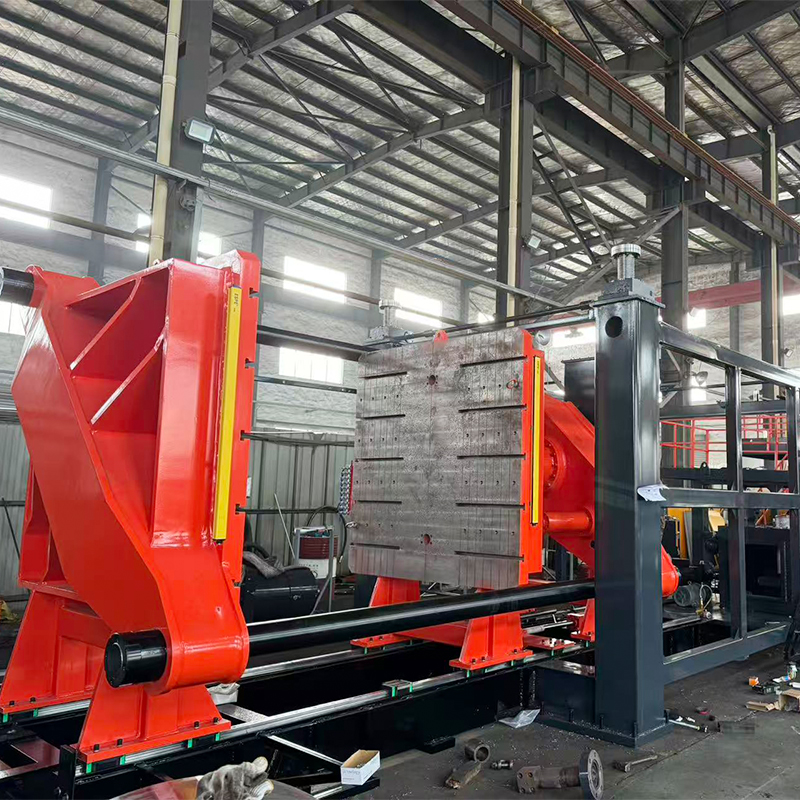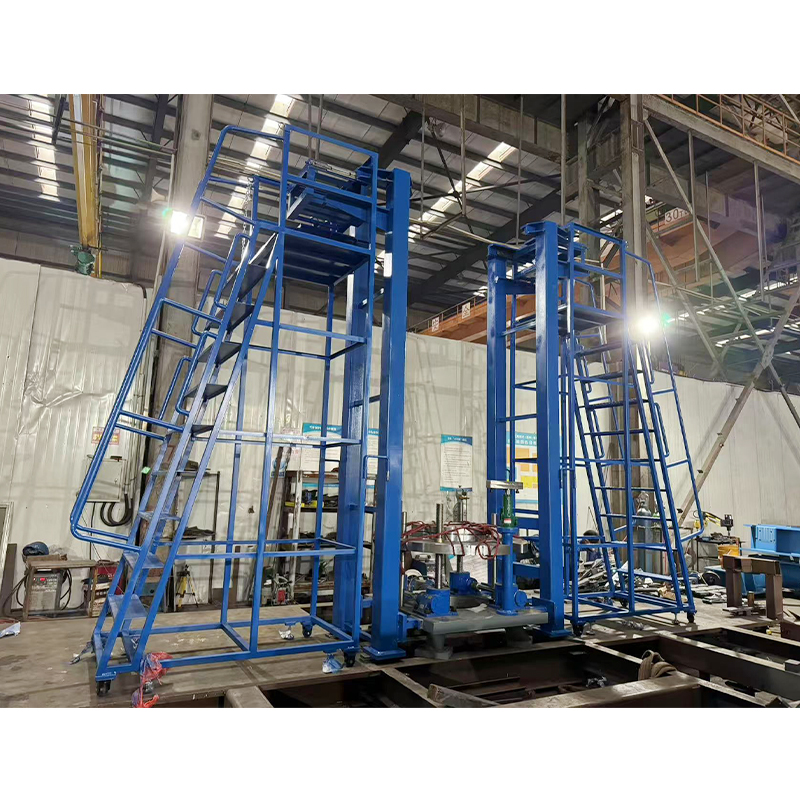How do blow molding machines achieve uniform bottle wall thickness to improve product strength?
Release Time : 2025-11-03
In the production of hollow plastic products, the uniformity of the bottle wall thickness directly determines the product's physical properties, appearance quality, and safety. Excessively thick sections not only waste raw materials and increase costs but may also lead to uneven cooling and internal stress; while excessively thin areas are prone to becoming structural weaknesses, deforming or even breaking during pressure testing or transportation. Therefore, ensuring a reasonable thickness distribution for every inch of the bottle body is one of the core challenges of blow molding technology. How do blow molding machines achieve uniform bottle wall thickness to improve product strength? The answer lies in their sophisticated control system and dynamic adjustment capabilities.
The basic principle of blow molding is to place molten plastic preforms in a mold, inflate them with compressed air to fit the mold cavity, and then cool them to form the desired shape. However, if inflation is performed using fixed parameters, the preform will exhibit unevenness due to gravity during free descent—thicker at the top and thinner at the bottom. If this natural descent effect is not addressed, the mechanical properties of the final product will be significantly compromised. Modern blow molding machines achieve precise wall thickness control by actively controlling the shape changes of the preform through a series of intelligent methods.
The key lies in the application of the preform wall thickness control system. This system can adjust the opening and closing of the die in real time during the preform extrusion process, changing the plastic flow rate at different locations. For example, in the bottom area of the bottle body just before entering the mold, the system can instruct the die to briefly widen, allowing more molten material to pass through, thus compensating for the thinning caused by stretching during blowing; while in areas prone to accumulation, such as the shoulder or neck, the die is appropriately narrowed to avoid excess material. This dynamic adjustment is not preset but programmed according to product design requirements, ensuring that the thickness at each axial position conforms to the optimal distribution.
Furthermore, precise management of blowing pressure and blowing timing is also crucial. Gas applies pressure from inside the preform, pushing it outwards. If the pressure is too high or the start is too early, the preform may expand locally before fully positioning, resulting in localized thinning; if the pressure is insufficient or delayed, problems such as incomplete mold adhesion and blurred contours may occur. Advanced blow molding machines are equipped with multi-stage air blowing control, allowing for phased adjustment of air pressure and timing. This ensures the preform gradually and smoothly conforms to the mold, minimizing stretching differences and maintaining a continuous, uniform wall surface.
The mold's cooling system also plays a crucial role in this process. Uneven cooling leads to inconsistent plastic curing speeds, affecting the final thickness distribution. The design of efficient cooling channels, combined with zoned temperature control, maintains a constant temperature difference across different areas of the mold, ensuring rapid and uniform plastic curing upon contact with the mold wall and preventing excessive stretching due to localized overheating and softening.
The coordinated operation of the entire system relies on the precise scheduling of the central control unit. Operators only need to input product specifications and process parameters, and the control system automatically matches the optimal extrusion speed, die adjustment curve, air blowing program, and cooling rhythm. Sensors provide real-time feedback on preform position, temperature, and pressure status, forming a closed-loop control system that promptly corrects deviations, ensuring that every product meets design requirements.
Improved wall thickness uniformity directly translates into increased product strength. A more even distribution of stress on the bottle surface enhances resistance to pressure, impact, and internal pressure. Whether it's packaging bottles subjected to stacking pressure or industrial containers requiring sealing and pressure maintenance, the blow molding machine maintains structural integrity under complex operating conditions. Simultaneously, material utilization is optimized, reducing unnecessary thickening and achieving a balance between lightweight and high strength.
In summary, the blow molding machine achieves precise control over bottle thickness through preform wall thickness control, air blowing management, cooling coordination, and intelligent system integration. It's not merely a combination of mechanical actions, but a precise control of material flow, heat conduction, and pressure distribution. Under the influence of this system, each blow-molded product gains enhanced vitality and reliability.
The basic principle of blow molding is to place molten plastic preforms in a mold, inflate them with compressed air to fit the mold cavity, and then cool them to form the desired shape. However, if inflation is performed using fixed parameters, the preform will exhibit unevenness due to gravity during free descent—thicker at the top and thinner at the bottom. If this natural descent effect is not addressed, the mechanical properties of the final product will be significantly compromised. Modern blow molding machines achieve precise wall thickness control by actively controlling the shape changes of the preform through a series of intelligent methods.
The key lies in the application of the preform wall thickness control system. This system can adjust the opening and closing of the die in real time during the preform extrusion process, changing the plastic flow rate at different locations. For example, in the bottom area of the bottle body just before entering the mold, the system can instruct the die to briefly widen, allowing more molten material to pass through, thus compensating for the thinning caused by stretching during blowing; while in areas prone to accumulation, such as the shoulder or neck, the die is appropriately narrowed to avoid excess material. This dynamic adjustment is not preset but programmed according to product design requirements, ensuring that the thickness at each axial position conforms to the optimal distribution.
Furthermore, precise management of blowing pressure and blowing timing is also crucial. Gas applies pressure from inside the preform, pushing it outwards. If the pressure is too high or the start is too early, the preform may expand locally before fully positioning, resulting in localized thinning; if the pressure is insufficient or delayed, problems such as incomplete mold adhesion and blurred contours may occur. Advanced blow molding machines are equipped with multi-stage air blowing control, allowing for phased adjustment of air pressure and timing. This ensures the preform gradually and smoothly conforms to the mold, minimizing stretching differences and maintaining a continuous, uniform wall surface.
The mold's cooling system also plays a crucial role in this process. Uneven cooling leads to inconsistent plastic curing speeds, affecting the final thickness distribution. The design of efficient cooling channels, combined with zoned temperature control, maintains a constant temperature difference across different areas of the mold, ensuring rapid and uniform plastic curing upon contact with the mold wall and preventing excessive stretching due to localized overheating and softening.
The coordinated operation of the entire system relies on the precise scheduling of the central control unit. Operators only need to input product specifications and process parameters, and the control system automatically matches the optimal extrusion speed, die adjustment curve, air blowing program, and cooling rhythm. Sensors provide real-time feedback on preform position, temperature, and pressure status, forming a closed-loop control system that promptly corrects deviations, ensuring that every product meets design requirements.
Improved wall thickness uniformity directly translates into increased product strength. A more even distribution of stress on the bottle surface enhances resistance to pressure, impact, and internal pressure. Whether it's packaging bottles subjected to stacking pressure or industrial containers requiring sealing and pressure maintenance, the blow molding machine maintains structural integrity under complex operating conditions. Simultaneously, material utilization is optimized, reducing unnecessary thickening and achieving a balance between lightweight and high strength.
In summary, the blow molding machine achieves precise control over bottle thickness through preform wall thickness control, air blowing management, cooling coordination, and intelligent system integration. It's not merely a combination of mechanical actions, but a precise control of material flow, heat conduction, and pressure distribution. Under the influence of this system, each blow-molded product gains enhanced vitality and reliability.







